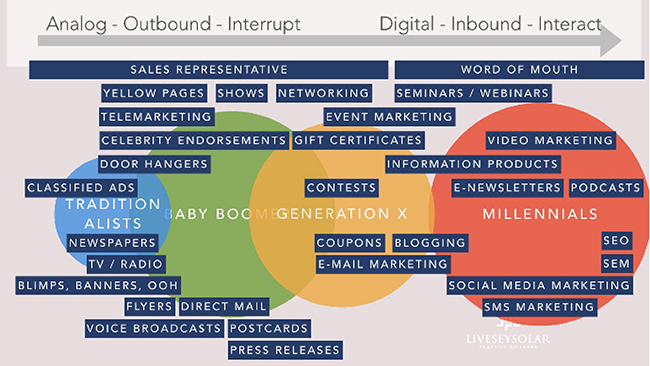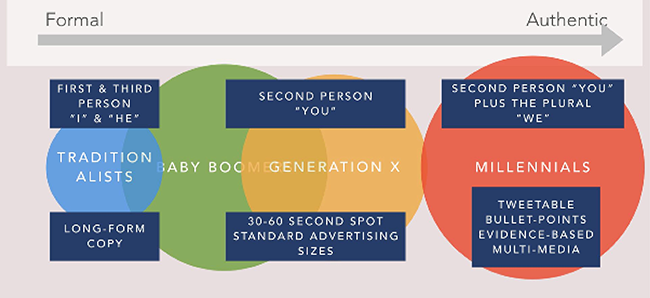From traditionalists to baby boomers and Gen Xers to millennials, each generation maintains some common characteristics, values, and behaviors. In order to effectively reach and serve these different groups of individuals, refractive surgeons must segment and differentiate their marketing approaches according to their generational identities (Table 1).

Laser refractive surgeons focus mainly on millennials. They must therefore understand the unique ways in which millennials respond to:
- Specific marketing channels, or where you reach customers;
- Marketing messages, or what you say to them;
- Communication styles, or how you say it;
- Interaction styles, or how they like to interact; and
- Pricing approaches, or what and how they’ll pay.
This article delves deeper into each category, highlighting what’s changing and how ophthalmologists can adapt.
MARKETING CHANNELS
Figure 1 shows a selection of marketing tactics layered over the generations with which they resonate most. With the marketing tactics on the left, the marketer commonly pushes a message out far and wide, hoping that it resonates with the relatively few people who might be interested.

Figure 1 | Marketing tactics and how they map across generations. The circle sizes represent the relative populations of these generations in Europe. Similar proportions live in the United States.
Thousands of these so-called outbound marketing messages interrupt consumers every day. The youngest consumers do their best to block them; millions opt out of lists and avoid broadcast media fueled by interruptive advertising. This trend appears within the context of a regulatory environment that aims to better protect consumer privacy from intrusive advertising practices.
Today, younger consumers often initiate an interactive inbound marketing conversation. With the emergence of internet search, prospective patients interested in your offerings seek you out, as opposed to you seeking them out. For inbound marketing to work, you must provide value in the form of shareable, high-quality, relevant content. You need to entertain and educate to succeed.
When marketing to millennials:
- Focus your marketing budget toward inbound digital channels.
- Think about marketing as having conversations instead of pushing messages.
- Begin exploring interactive media where consumers can participate (eg, social media) and learn.
- Prominently feature patient reviews and ratings from independent third-party review sites. Millennials trust objective opinions offered by peers more than they trust authority.

Figure 2 | Marketing messages and how they map across generations.
MARKETING MESSAGES
Traditionalists are accustomed to marketing messages that focus on, “It’s all about me,” where the “me” is the company or provider of the service (Figure 2). The kinds of advertisements that you would see in the past are those that focused entirely on the company.
In the 1960s, David Ogilvy, the so-called father of advertising, thought, “These headlines can’t be all about us. They’ve got to be about our customers. They’ve got to be about the benefits that we’re offering people.” So, advertisers began answering the question, “What’s in it for me?” with “me” being the baby boomer consumer.
Today, the marketing message has evolved into, “It’s all about us.” Millennials want to know how your company participates in the community—locally or globally. So, how should you tailor your marketing messaging accordingly?
When marketing to millennials:
- Consider allocating some of your net profits to causes you and your customers mutually care about (eg, the environment, inequality, and education).
- Focus your messages on helping them maximize their experiences (they’re more interested in experiences than material goods).
- Feature millennials using their vision to maximize their experiences in daily life (with photography and third-party stories).
- Enable them to share their experience of having laser eye surgery with their friends and family—it is a life event.

Figure 3 | Communication styles and how they map across generations.
COMMUNICATION STYLES
We’re moving toward a more informal and authentic communication style (Figure 3). Millennials want to know, “Who are you, really?” Secondly, they want to know, “Do you understand us?” and “Can we work together to solve my problems?”
When marketing to millennials:
- Write clearly and succinctly and use the active voice.
- Use one idea per sentence.
- Break down what you’re talking about into bullet points.
- Provide evidence for your claims and cite your sources.
- Share personal information about yourself, your family, your (nonoccupational) weaknesses and vulnerabilities, and your nonwork experiences; anything you can do to help millennials relate to you as a real person will help them trust you more.
- Display what you do using multimedia. Use text, video, diagrams, infographics, and quizzes. Facilitate learning and enable participation with interactive tools and calculators.
- Use one webpage per topic. Millennials will happily navigate to a fast loading page with just enough information to answer a specific question of interest.

Figure 4 | Interaction styles and how they map across generations.
INTERACTION STYLES
Traditionalists are accustomed to single-channel, didactic, clinically focused, and doctor-led patient interactions in a face-to-face setting. In the past, the doctor did most of the talking, and the patient did most of the listening.
Now, however, we are moving toward a multichannel, autodidactic, emotionally focused, and patient-led model for medical interactions (Figure 4). Patients today might speak with their physicians on the phone, via Skype, and then in person. You might even text each other before and after surgery. Patients ask more questions than they did before, so physicians need to focus on listening more than talking.
In the past, the elite possessed all of the medical information. Now we’re seeing consumers in general become more educated and responsible for their health. They’re walking into doctors’ offices armed with reams of information about their condition and their treatment options.
Millennials are high-information patients. They are without a doubt the most educated patients, and they have had a longer, better, and more specialized education than any other generation. Millennials are also autodidacts; they imagine that pretty much anything worth knowing is freely available on the internet, and they are expert searchers.
When marketing to millennials:
- Be available by chat, by phone, and in person.
- Respond instantly when possible. Millennials expect absolute convenience and immediacy. For example, they’ll interact with bots if they can get the information they need more quickly from a machine than a human operator.
- Invite family members to consultations.
- Allow more time to address questions.
- Be flexible in how you communicate. Don’t solely rely on mail or phone.
- Work on your listening skills, on the phone and in consultations.

Figure 5 | Pricing and financing and how they map across generations.
PRICING APPROACHES
Cash is no longer king. We’re moving toward a cashless and debit-based society (Figure 5). A typical millennial’s discretionary income is small in comparison to Gen Xers’ and baby boomers’. Millennials are more often single and mobile, and they tend to have less income, fewer assets, and a higher debt load. All of these factors contribute to difficulty when accessing credit, especially in an environment that is getting more credit-restrictive. Traditionally speaking, about 25% of patients use financing. Millennials may not have access to that payment option.
When marketing to millennials:
- Be flexible with payments that do not necessarily rely on traditional credit arrangements.
- Reconsider your pricing for treatments aimed at younger people.
- Consider that millennial patients will likely put off treatment if they can’t afford it. They’ve put off more important things, such as buying a home, getting married, and paying for school. They have a long investment horizon for their money to grow.
CONCLUSION
There is no doubt that, of all the criteria that explain a consumer’s behavior, the most crucial is his or her age and generation. This unavoidable fact affects everything, from what you say, where you say it, how you say it, and what you charge for your offerings. What appeals to a millennial may irritate a baby boomer. What delights a baby boomer may make a millennial cringe. You must seek to understand your audience if you hope for them to understand you. Generational marketing provides markers to help you do just that.
1. US population by age and generation. Knoema. https://knoema.com/egyydzc/us-population-by-age-and-generation. Accessed May 20, 2018.




